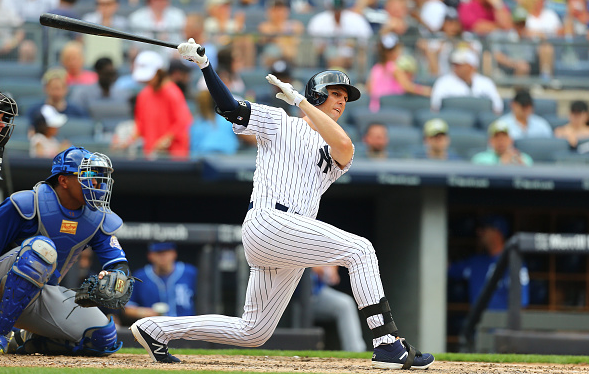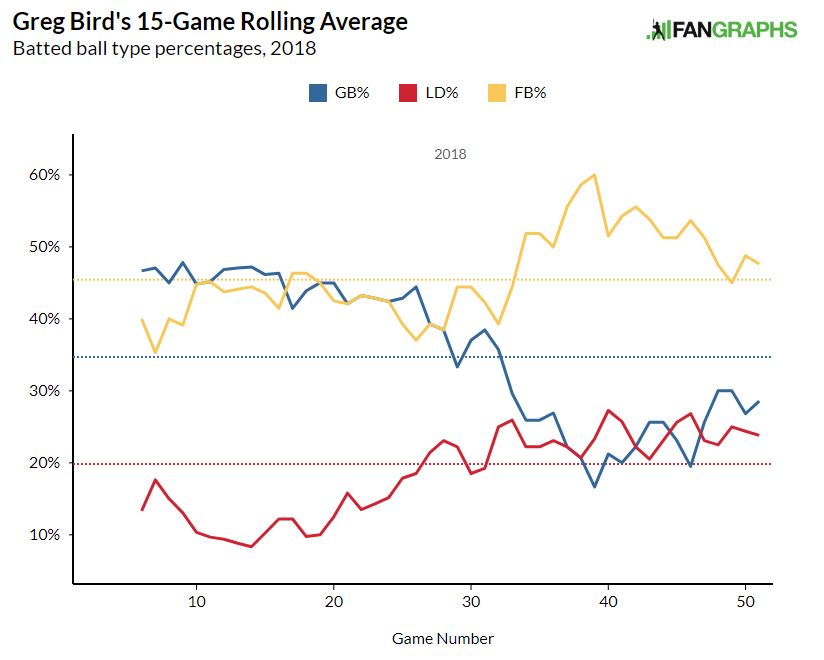It’s no secret that Greg Bird has had a little trouble remaining healthy in his major league career thus far. A few years ago, he had shoulder problems. Last year, he fouled a ball off of his ankle in spring training that ultimately required surgery. This year, a bone spur emerged in his ankle that was surgically removed.
“The more I was on it, the worse it got,” Bird told the New York Daily News back in April. “I couldn’t stand by the end of [one] game.” The Yankees’ depth was tested and they used a combination of Neil Walker and the recently traded Tyler Austin at first base in the interim. Bird finally returned to the lineup May 15 and had a mixed bag of results…until recently.
Coming up through the Yankee organization, the scouting report on Bird was lots of solid contact, and lots of walks. When healthy, he is spraying line drives to all fields, and driving the ball out of the ballpark. However, that wasn’t happening when he first came back.
Bird was hitting an extreme amount of ground balls, and it was affecting his power output. His ground ball percentage was 45.5 percent and 40.4 percent in May and June, respectively. That’s not what you want from a power hitter. Right around game 30 in the chart below, you can see the reduction in his ground balls and the increase in line drives and fly balls.
From the time Bird came back until June 28, Bird hit .191/.308/.382. (91 wRC+) which is very underwhelming, especially if you consider the position he plays. He was hitting way too many ground balls, and his overall production was suffering because of that.
However there was a specific game I can pick out where everything changed. It was June 29 against the Red Sox, the day of our Bronx Pinstripes event. Bird came up in the fourth inning and I was sitting next to Scott Reinen himself. Scott leaned in and said “What has Bird done lately?” The very next pitch went into left field for an opposite field home run. He would later tack on another homer in that game and this started his turnaround.
Since June 29, Bird is hitting .275/.346/.516. (127 wRC+). As referenced in the chart above, this is right around the time Bird had changed his batted ball profile.
Bird has also been hitting the ball with more authority lately, as well. His hard hit percentage (balls hit over 95 mph) was right at 39.7 percent for the month of July. It was only 32.7 percent in the month of June. His career rate is at 43.8 percent so there may even be more room for improvement there.
It took Greg about a month or so, but I think he is just now getting back to his normal self. This is not uncommon for players who essentially miss spring training. “Rehab” games aren’t the same as game action. See below for his hard hit and medium hit percentages. They are basically inversely proportional after game 30, when he started hitting the ball in the air more.
Traditionally the Yankees are built with lots of left handed power, but that’s not really the case for this team. The team’s best lefty power bat the last few seasons has been Didi Gregorius, and I’m not sure that’s the ideal scenario, given their short porch.
The Yankees would love for Bird to continue his resurgence and become not only the team’s best lefty bat, but perhaps slot into the three hole between Judge and Stanton, when everyone is healthy.






